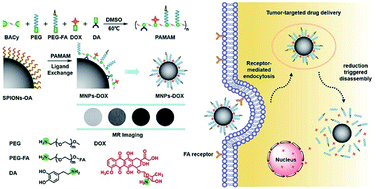Our official English website, www.x-mol.net, welcomes your feedback! (Note: you will need to create a separate account there.)
Surface design and preparation of multi-functional magnetic nanoparticles for cancer cell targeting, therapy, and imaging
RSC Advances ( IF 3.9 ) Pub Date : 2018-10-16 00:00:00 , DOI: 10.1039/c8ra06718j Jing Qu 1 , Zhijie Tian 2 , Qiuyue Wang 1 , Si Peng 1 , Jian-Bin Luo 1 , Qing-Han Zhou 1 , Juan Lin 2
RSC Advances ( IF 3.9 ) Pub Date : 2018-10-16 00:00:00 , DOI: 10.1039/c8ra06718j Jing Qu 1 , Zhijie Tian 2 , Qiuyue Wang 1 , Si Peng 1 , Jian-Bin Luo 1 , Qing-Han Zhou 1 , Juan Lin 2
Affiliation

|
Recently, theranostic candidates based on superparamagnetic iron oxide nanoparticles (SPIONs) providing the combination of therapy and diagnosis have become one of the most promising system in cancer research. However, poor stability, premature drug release, lack of specific tumor cell targeting, and complicated multi-step synthesis processes still hinder them for potential clinical applications. In this research, the multi-functional magnetic nanoparticles (MNPs-DOX) were prepared via a simple assembly process for targeted delivery of doxorubicin (DOX) and enhanced magnetic resonance (MR) imaging detection. Firstly, the multi-functional copolymer coating, polyamidoamine (PAMAM), was designed and synthesized by Michael addition reaction, where N,N-bis(acryloyl)cystamine served as backbone linker, and DOX, dopamine (DA), and polyethylene glycol (PEG) acted as comonomers. The PAMAM was then directly assembled to the surface of SPIONs by the ligand exchange reaction with SPIONs forming the MNPs-DOX. The hydrophilic PEG moieties provide the nanoparticles with colloidal stability and good-dispersity in aqueous solution. Comparing with the quick release of free DOX, the drug release behavior of MNPs-DOX exhibited a sustained drug release. Because the chemical cleavage of disulfide in the polymer backbone, a high cumulative drug release up to 60% in GSH within 48 h was observed, rather than only 26% in PBS (pH 7.4) without GSH. The MR imaging detection experiment showed that the MNPs-DOX had an enhanced T2 relaxivity of 126 mM−1 S−1 for MR imaging. The results of the cytotoxicity assays showed a remarkable killing effect of cancer cells by MNPs-DOX due to the FA tumor-targeting ligand, comparing with non-targeted drug molecules. All the results showed that the as prepared multi-functional magnetic nanoparticles may serve as a promising theranostic candidate for targeted anticancer drug delivery and efficient detection through MR imaging in medical application.
中文翻译:

用于癌细胞靶向、治疗和成像的多功能磁性纳米粒子的表面设计和制备
最近,基于超顺磁性氧化铁纳米粒子(SPIONs)的治疗诊断候选物提供了治疗和诊断的结合,已成为癌症研究中最有前途的系统之一。然而,稳定性差、药物释放过早、缺乏特异性肿瘤细胞靶向性以及复杂的多步骤合成过程仍然阻碍了它们在临床上的应用。在这项研究中,通过简单的组装工艺制备了多功能磁性纳米粒子(MNPs-DOX),用于靶向递送阿霉素(DOX)和增强磁共振(MR)成像检测。首先,通过迈克尔加成反应设计并合成了多功能共聚物涂层聚酰胺胺(PAMAM),其中N , N-双(丙烯酰基)胱胺作为主链接头,DOX、多巴胺(DA)和聚乙二醇(PEG)作为共聚单体。然后通过与 SPION 的配体交换反应将 PAMAM 直接组装到 SPION 的表面,形成 MNPs-DOX。亲水性PEG部分为纳米颗粒提供胶体稳定性和在水溶液中的良好分散性。与游离 DOX 的快速释放相比,MNPs-DOX 的药物释放行为表现出持续的药物释放。由于聚合物骨架中二硫键的化学裂解,在 48 小时内观察到 GSH 中高达 60% 的高累积药物释放,而不是在没有 GSH 的 PBS(pH 7.4)中仅为 26%。MR成像检测实验表明MNPs-DOX具有126 mM -1的增强的T 2弛豫率S -1用于 MR 成像。与非靶向药物分子相比,细胞毒性试验结果表明,由于 FA 肿瘤靶向配体,MNPs-DOX 对癌细胞具有显着的杀伤作用。所有结果表明,所制备的多功能磁性纳米粒子可作为一种有前途的治疗诊断候选物,用于靶向抗癌药物递送和通过 MR 成像在医学应用中进行有效检测。
更新日期:2018-10-16
中文翻译:

用于癌细胞靶向、治疗和成像的多功能磁性纳米粒子的表面设计和制备
最近,基于超顺磁性氧化铁纳米粒子(SPIONs)的治疗诊断候选物提供了治疗和诊断的结合,已成为癌症研究中最有前途的系统之一。然而,稳定性差、药物释放过早、缺乏特异性肿瘤细胞靶向性以及复杂的多步骤合成过程仍然阻碍了它们在临床上的应用。在这项研究中,通过简单的组装工艺制备了多功能磁性纳米粒子(MNPs-DOX),用于靶向递送阿霉素(DOX)和增强磁共振(MR)成像检测。首先,通过迈克尔加成反应设计并合成了多功能共聚物涂层聚酰胺胺(PAMAM),其中N , N-双(丙烯酰基)胱胺作为主链接头,DOX、多巴胺(DA)和聚乙二醇(PEG)作为共聚单体。然后通过与 SPION 的配体交换反应将 PAMAM 直接组装到 SPION 的表面,形成 MNPs-DOX。亲水性PEG部分为纳米颗粒提供胶体稳定性和在水溶液中的良好分散性。与游离 DOX 的快速释放相比,MNPs-DOX 的药物释放行为表现出持续的药物释放。由于聚合物骨架中二硫键的化学裂解,在 48 小时内观察到 GSH 中高达 60% 的高累积药物释放,而不是在没有 GSH 的 PBS(pH 7.4)中仅为 26%。MR成像检测实验表明MNPs-DOX具有126 mM -1的增强的T 2弛豫率S -1用于 MR 成像。与非靶向药物分子相比,细胞毒性试验结果表明,由于 FA 肿瘤靶向配体,MNPs-DOX 对癌细胞具有显着的杀伤作用。所有结果表明,所制备的多功能磁性纳米粒子可作为一种有前途的治疗诊断候选物,用于靶向抗癌药物递送和通过 MR 成像在医学应用中进行有效检测。



























 京公网安备 11010802027423号
京公网安备 11010802027423号